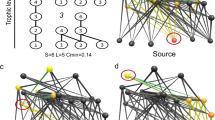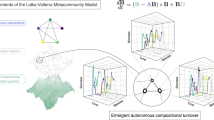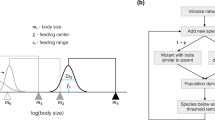Abstract
Growing concern about how loss of biodiversity will affect ecosystems has stimulated numerous studies1,2,3,4,5. Although most studies have assumed that species go extinct randomly6,7,8, species often go extinct in order of their sensitivity to a stress that intensifies through time (such as climate change)9. Here we show that the consequences of random and ordered extinctions differ. Both depend on food-web interactions that create compensation; that is, the increase of some species when their competitors and/or predators decrease in density due to environmental stress. Compensation makes communities as a whole more resistant to stress by reducing changes in combined species densities. As extinctions progress, the potential for compensation is depleted, and communities become progressively less resistant. For ordered extinctions, however, this depletion is offset and communities retain their resistance, because the surviving species have greater average resistance to the stress. Despite extinctions being ordered, changes in the food web with successive extinctions make it difficult to predict which species will show compensation in the future. This unpredictability argues for ‘whole-ecosystem’ approaches to biodiversity conservation, as seemingly insignificant species may become important after other species go extinct.
This is a preview of subscription content, access via your institution
Access options
Subscribe to this journal
Receive 51 print issues and online access
$199.00 per year
only $3.90 per issue
Buy this article
- Purchase on Springer Link
- Instant access to full article PDF
Prices may be subject to local taxes which are calculated during checkout



Similar content being viewed by others
References
Sala, O. E. et al. Global biodiversity scenarios for the year 2100. Science 287, 1170–1174 (2000)
Chapin, F. S. I. et al. Consequences of changing biodiversity. Nature 405, 234–242 (2000)
Ehrlich, P. & Ehrlich, A. Extinction (Random House, New York, 1981)
Terborgh, J. et al. Ecological meltdown in predator-free forest fragments. Science 294, 1923–1926 (2001)
Naeem, S., Thompson, L. J., Lawler, S. P., Lawton, J. H. & Woodfin, R. M. Declining biodiversity can alter the performance of ecosystems. Nature 368, 734–737 (1994)
Naeem, S. Ecology—Power behind diversity's throne. Nature 401, 653–654 (1999)
Tilman, D. et al. Diversity and productivity in a long-term grassland experiment. Science 294, 843–845 (2001)
Hector, A. et al. Plant diversity and productivity experiments in European grasslands. Science 286, 1123–1127 (1999)
Vitousek, P. M., Mooney, H. A., Lubchenco, J. & Melillo, J. M. Human domination of the Earth's ecosystems. Science 277, 494–499 (1997)
Davis, A. J., Jenkinson, L. S., Lawton, J. H., Shorrocks, B. & Wood, S. Making mistakes when predicting shifts in species range in response to global warming. Nature 391, 783–786 (1998)
Ives, A. R. Predicting the response of populations to environmental change. Ecology 76, 926–941 (1995)
Case, T. J. & Bender, E. A. Testing for higher order interactions. Am. Nat. 118, 920–929 (1981)
Yodzis, P. Introduction to Theoretical Ecology (Harper & Row, New York, 1989)
Frost, T. M., Carpenter, S. R., Ives, A. R. & Kratz, T. K. in Linking Species and Ecosystems (eds Jones, C. G. & Lawton, J. H.) 224–239 (Chapman and Hall, New York, 1995)
Ives, A. R., Carpenter, S. R. & Dennis, B. Community interaction webs and the response of a zooplankton community to experimental manipulations of planktivory. Ecology 80, 1405–1421 (1999)
McGrady-Steed, J. & Morin, P. J. Biodiversity, density compensation, and the dynamics of populations and functional groups. Ecology 81, 361–373 (2000)
Tilman, D. Biodiversity: Population versus ecosystem stability. Ecology 77, 350–363 (1996)
Ostfeld, R. S. & LoGuidice, K. Community disassembly, biodiversity, loss, and the erosion of an ecosystem function. Ecology 84, 1421–1427 (2003)
Pimm, S. L., Jones, H. L. & Diamond, J. On the risk of extinction. Am. Nat. 132, 757–785 (1988)
MacArthur, R. H. Geographical Ecology (Harper and Row, New York, 1972)
Smith, M. D. & Knapp, A. K. Dominant species maintain ecosystem function with non-random species loss. Ecol. Lett. 6, 509–517 (2003)
May, R. M. Stability and Complexity in Model Ecosystems 2nd edn (Princeton Univ. Press, Princeton, New Jersey, 1974)
Pimm, S. L. Food Webs (Chapman and Hall, London, 1982)
Tilman, D., Wedin, D. & Knops, J. Productivity and sustainability influenced by biodiversity in grassland ecosystems. Nature 379, 718–720 (1996)
Peres, C. A. & Dolman, P. M. Density compensation in neotropical primate communities: evidence from 56 hunted and nonhunted Amazonian forests of varying productivity. Oecologia 122, 175–189 (2000)
Klug, J. L., Fischer, J. M., Ives, A. R. & Dennis, B. Compensatory dynamics in planktonic community responses to pH perturbations. Ecology 81, 387–398 (2000)
Paine, R. T. Food web complexity and species diversity. Am. Nat. 100, 65–75 (1966)
Diaz, S., Symstad, A. J., Chapin, F. S., Wardle, D. A. & Huenneke, L. F. Functional diversity revealed by removal experiments. Trends Ecol. Evol. 18, 140–146 (2003)
Wootton, J. T. Prediction in complex communities: Analysis of empirically derived Markov models. Ecology 82, 580–598 (2001)
Laska, M. S. & Wootton, J. T. Theoretical concepts and empirical approaches to measuring interaction strength. Ecology 79, 461–476 (1998)
Acknowledgements
We thank J. Boughman, S. R. Carpenter, A. E. Forbes, R. Haygood, C. T. Harvey, M. R. Helmus, K. J. Tilmon and M. J. Vander Zanden for help. Funding was provided by the US National Science Foundation.
Author information
Authors and Affiliations
Corresponding author
Ethics declarations
Competing interests
The authors declare that they have no competing financial interests.
Supplementary information
Supplementary Methods
Detailed explanations of the mathematical analyses in the paper and generalisations of major results using analytical theory. (PDF 18 kb)
Rights and permissions
About this article
Cite this article
Ives, A., Cardinale, B. Food-web interactions govern the resistance of communities after non-random extinctions. Nature 429, 174–177 (2004). https://doi.org/10.1038/nature02515
Received:
Accepted:
Issue Date:
DOI: https://doi.org/10.1038/nature02515
This article is cited by
-
Predator mass mortality events restructure food webs through trophic decoupling
Nature (2024)
-
Alteration of coastal productivity and artisanal fisheries interact to affect a marine food web
Scientific Reports (2021)
-
Biogeochemical extremes and compound events in the ocean
Nature (2021)
-
An ecological network approach to predict ecosystem service vulnerability to species losses
Nature Communications (2021)
-
Robustness to extinction and plasticity derived from mutualistic bipartite ecological networks
Scientific Reports (2020)
Comments
By submitting a comment you agree to abide by our Terms and Community Guidelines. If you find something abusive or that does not comply with our terms or guidelines please flag it as inappropriate.



